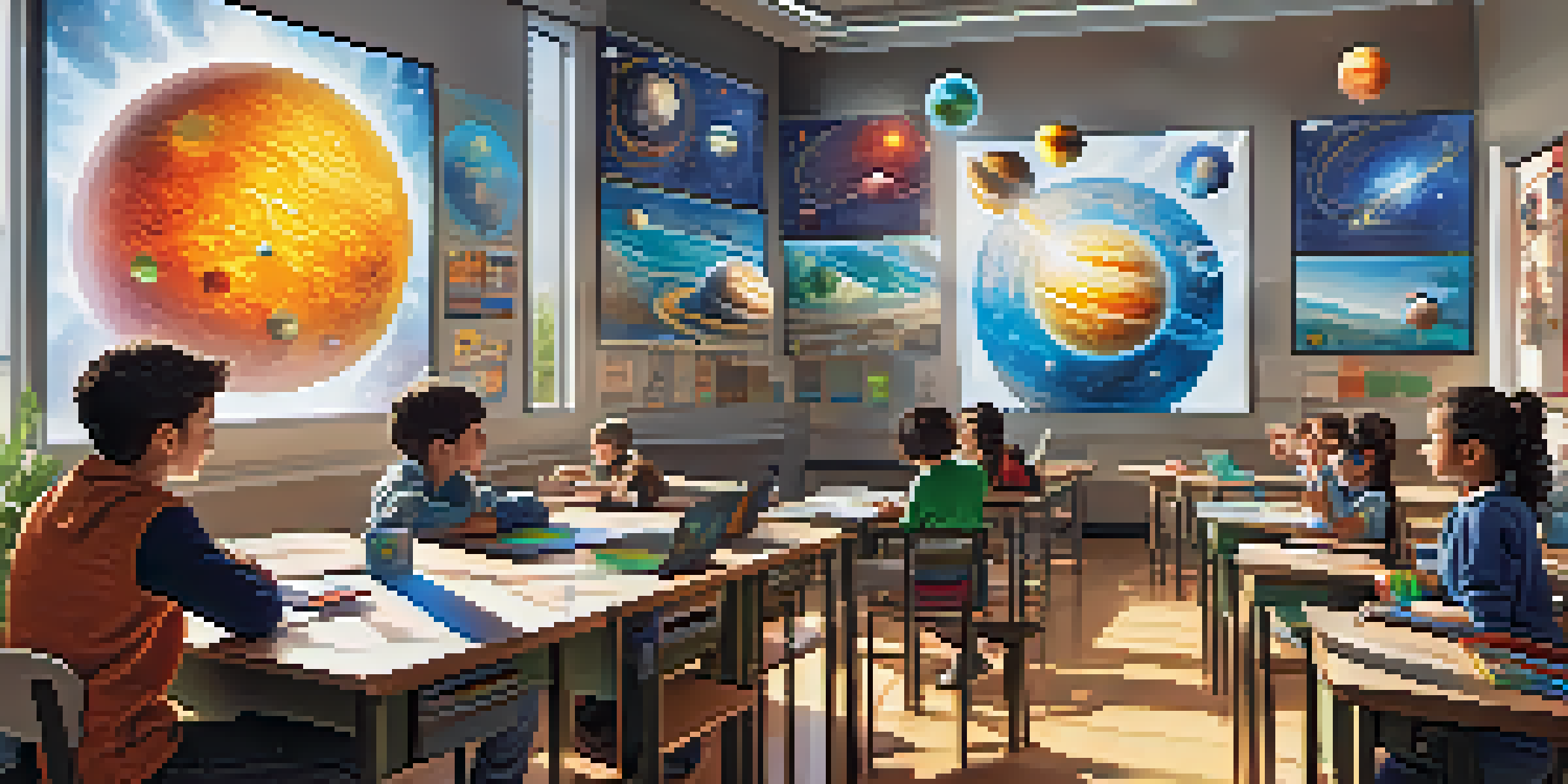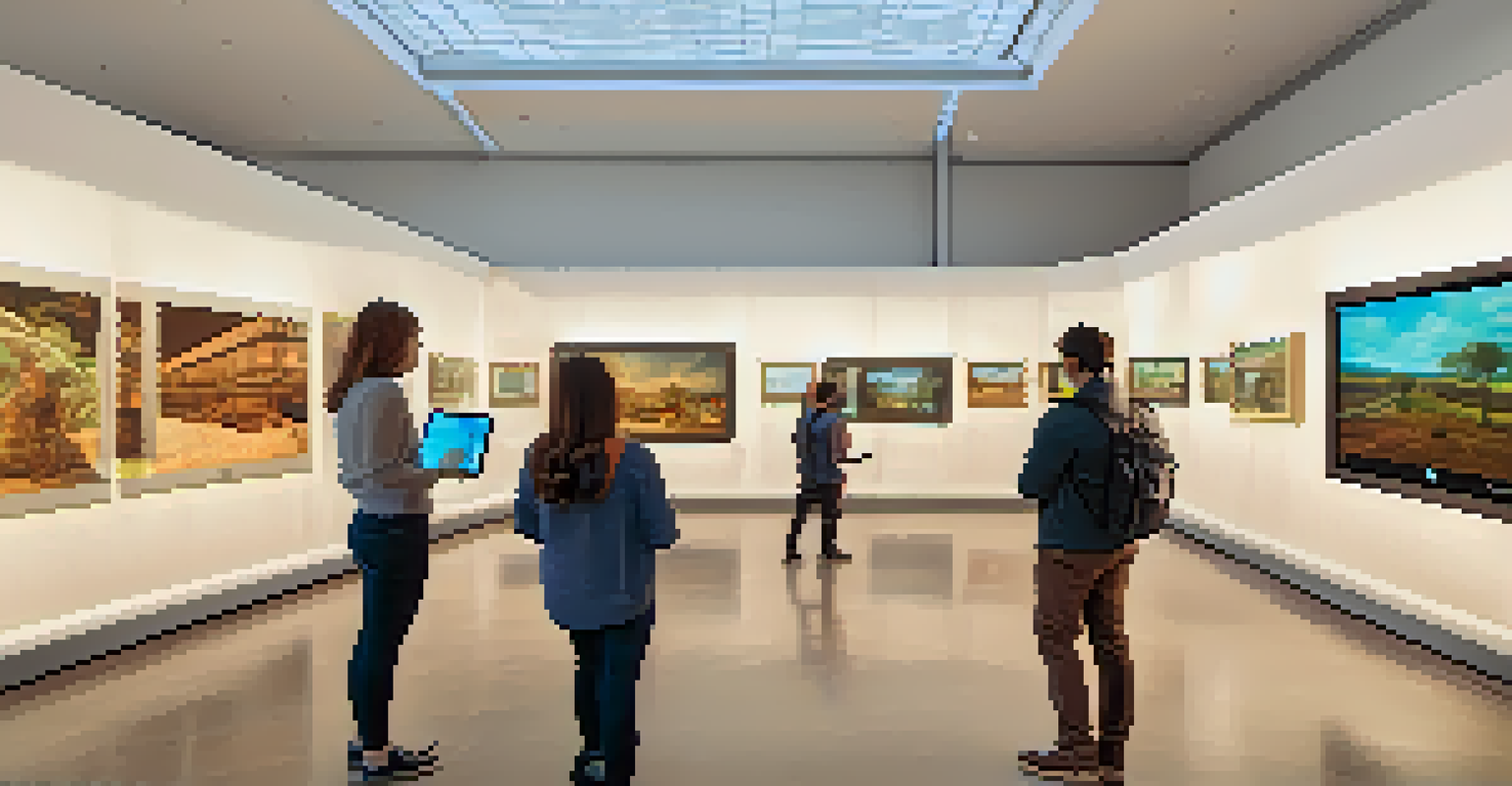The Impact of Augmented Reality on Transmedia Learning

Understanding Augmented Reality in Learning Contexts
Augmented Reality (AR) blends digital content with the physical world, creating interactive experiences. This technology enhances learning by overlaying information onto real-world environments, making complex concepts more tangible. Imagine learning about the solar system by seeing planets rotate around you in your living room—this is the magic of AR.
Augmented Reality will change the way we teach and learn, making education more engaging and interactive.
In educational settings, AR can transform traditional lessons into engaging explorations. For instance, students can interact with 3D models of historical artifacts or biological specimens, fostering a deeper understanding. This immersive approach not only captures attention but also aids in retention, making learning more effective.
As AR technology continues to evolve, it's crucial for educators to understand its potential. By integrating AR into curricula, they can create dynamic learning experiences that cater to various learning styles, ultimately enriching the educational landscape.
What is Transmedia Learning and Its Importance
Transmedia learning refers to the practice of using multiple media platforms to enhance the learning experience. This approach allows learners to engage with content in diverse ways, such as through videos, articles, games, and social media. By utilizing various formats, educators can reach a broader audience and cater to different learning preferences.

Imagine a history lesson that combines a documentary, an interactive website, and a social media campaign. Each platform provides unique insights and perspectives, encouraging students to explore the subject from multiple angles. This interconnectedness fosters critical thinking and deeper comprehension, as learners draw connections between different media.
AR Transforms Learning Experiences
Augmented Reality enhances education by making complex concepts tangible through interactive, immersive experiences.
The beauty of transmedia learning lies in its flexibility; it can be adapted to any subject and tailored to specific learning objectives. By embracing this approach, educators can create a rich tapestry of knowledge that resonates with students, making learning not just an obligation but an exciting adventure.
How Augmented Reality Enhances Transmedia Learning
The combination of AR and transmedia learning opens up a world of possibilities for educators and students alike. By integrating AR experiences with various media platforms, learners can interact with content in ways that were previously unimaginable. This fusion not only captivates students but also deepens their understanding of the material.
Transmedia learning encourages students to explore subjects through multiple lenses, fostering deeper understanding and critical thinking.
For example, a biology class could use AR to visualize cellular processes while simultaneously reading articles and watching videos. This multi-layered approach allows students to grasp complex ideas more easily, as they can see the concepts in action. The result is a richer learning experience that engages multiple senses and encourages exploration.
As educators begin to implement AR within transmedia frameworks, they can create a more holistic educational experience. This not only enhances engagement but also promotes collaboration among students, as they can share their discoveries and insights across different platforms.
Real-World Examples of AR in Transmedia Learning
Several educational institutions and organizations are already harnessing the power of AR in transmedia learning. For instance, the Smithsonian National Museum of Natural History offers an app that allows users to explore exhibits through AR, bringing history and science to life. This innovative approach invites visitors to interact with exhibits in a new and exciting way.
Another great example is the use of AR in language learning apps, where users can point their devices at objects to see translations and hear pronunciations. This interactive method not only aids vocabulary retention but also encourages learners to engage with their surroundings, making language acquisition more practical and fun.
Transmedia Learning Engages Diverse Learners
Utilizing multiple media platforms allows educators to cater to various learning styles, fostering deeper comprehension.
These examples illustrate how AR can be seamlessly integrated into various subjects and formats, enhancing the overall learning experience. As more educators and institutions adopt this technology, we can expect to see a significant shift in how knowledge is presented and absorbed.
Challenges of Implementing AR in Transmedia Learning
While the benefits of AR in transmedia learning are clear, there are also challenges that educators must navigate. One major hurdle is the cost and accessibility of AR technology. Not all schools have the resources to invest in the necessary equipment or software, which can create disparities in learning opportunities.
Additionally, educators may face a steep learning curve when it comes to integrating AR into their teaching methods. Designing AR content that aligns with learning objectives requires time, training, and technical skills. Without proper support and resources, teachers may feel overwhelmed and hesitant to embrace this innovative approach.
Finally, there is the challenge of ensuring that AR experiences are pedagogically sound. It's essential that the content is not just flashy but also meaningful, enhancing the learning process rather than distracting from it. Educators must strike a balance between engagement and educational value to maximize the impact of AR in the classroom.
The Future of Augmented Reality in Education
The future of AR in education looks promising, with rapid advancements in technology paving the way for more immersive learning experiences. As AR becomes more accessible and user-friendly, we can expect to see its integration in classrooms across the globe. This could lead to a transformation in how we approach teaching and learning.
Imagine a future where students can conduct virtual science experiments, explore distant planets, or interact with historical figures through AR. Such experiences could not only make learning more engaging but also foster a sense of curiosity and exploration in students. The potential for AR to create unforgettable learning moments is truly exciting.
Challenges in AR Adoption Exist
Despite its benefits, implementing AR in education faces hurdles like cost, accessibility, and the need for pedagogically sound content.
As educators and technologists collaborate to develop innovative AR tools, we can anticipate a new era of education that prioritizes experiential learning. By embracing these advancements, we have the opportunity to reshape the way knowledge is imparted and absorbed, making education a more dynamic and interactive experience.
Conclusion: Embracing AR in Transmedia Learning
In conclusion, the integration of Augmented Reality into transmedia learning offers unique opportunities for enhancing education. By leveraging the strengths of both AR and transmedia approaches, educators can create engaging, interactive experiences that resonate with students. This not only makes learning more enjoyable but also deepens understanding and retention.
As we continue to explore the potential of AR in the educational landscape, it's essential for educators to remain open to innovation. By embracing new technologies and teaching methods, they can cultivate a generation of learners who are not only knowledgeable but also curious and adaptable.

Ultimately, the journey toward integrating AR in transmedia learning is just beginning. As we navigate the challenges and embrace the possibilities, we can look forward to a future where education is not just about memorizing facts, but about experiencing knowledge in vibrant, engaging ways.